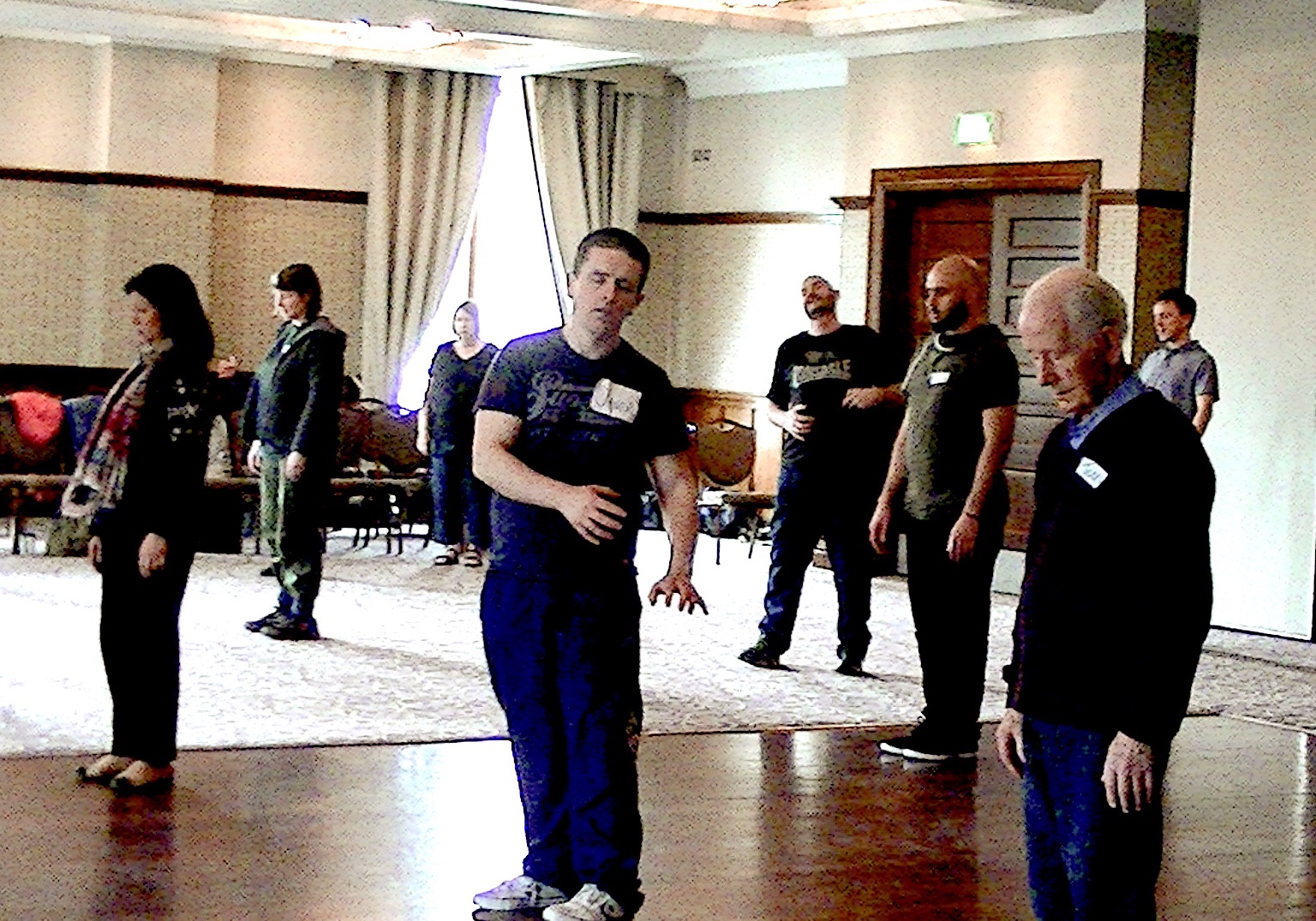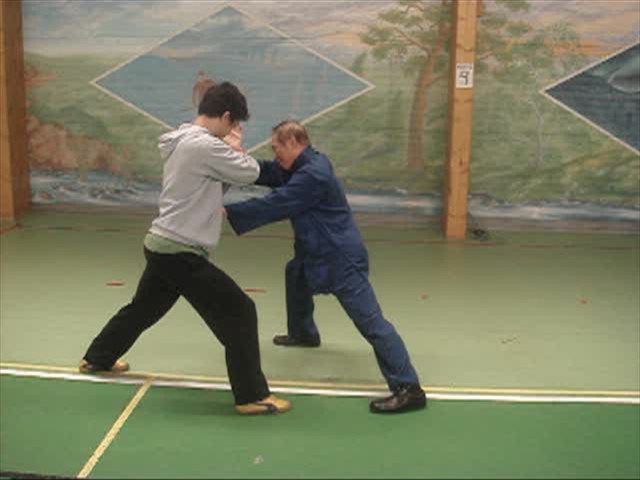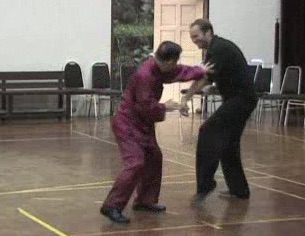SELECTION OF QUESTIONS AND ANSWERS
MAY 2018 PART 1

Students in this class in Ireland practiced chi kung, but more than 80% of practitioners practice gentle physical exercise although they use chi kung techniques
Question 1
Sifu, you have mentioned that many people say they practice chi kung but actually they practice gentle physical exercise. Can you tell us the difference between gentle physical exercise and chi kung?
— Alex, Russia
Answer
This is a very important topic. More than 80% of people who say that they practice chi kung, actually practice gentle physical exercise, and not chi kung.
Most of them are very nice people, and most of them do not realize the difference between gentle physical exercise and chi kung. They honestly but wrongly think that they practice chi kung. They use genuine chi kung techniques, but they practice the chi kung techniques as gentle physical exercise. They lack the skills to practice chi kung techniques as chi kung.
Hence, they do not have the benefits of chi kung, like good health, vitality and longevity. If they have these benefits, and we sincerely wish that they have, it is because of other reasons, and not because of their practice. Those who practice chi kung, which is actually rare nowadays, will have the benefits of good health, vitality and longevity from their practice.
The difference between gentle physical exercise and chi kung is in chi flow, or energy flow. In gentle physical exercise there is no chi flow. In chi kung there is chi flow.
Please note that the chi flow in our school is obvious. The chi flow is manifested as external movement. But in most other schools where students practice genuine chi kung and not just gentle physical exercise, their chi flow is mild and inside their body, usually not manifested out as external movement.
Chi flow is the essence of chi kung. Because there is no chi flow in gentle physical exercise, they have only the benefits of gentle physical exercise like good balance, being relaxed and being graceful, but they cannot overcome illness, have more energy, mental clarity and spiritual joys, which are the benefits of chi kung.
Question 2
You also have mentioned that there are three dimensions in chi kung training, which are form, energy and mind. Can you please tell us more about that?
Answer
Firstly, we need to differentiate between chi kung and gentle physical exercise. This may be difficult for people outside our school because both chi kung and gentle physical exercise use the same chi kung forms, or techniques.
In other words, when a person practices gentle physical exercise, he uses chi kung techniques. When a person practices chi kung he also uses chi kung techniques. But the skills are different. When a person practices chi kung, he uses chi kung skills. When a person practices gentle physical exercise, he does not know chi kung skills.
As an analogy, when a kungfu gymnast practices kungfu gymnastics he uses the same kungfu techniques as a genuine kungfu practitioner. But a kungfu gymnast does not have the skills to use his kungfu techniques for combat, but a genuine kungfu practitioner has.
Having differentiated between gentle physical exercise and chi kung, it is helpful to know that chi kung may be divided into three components, which are form, energy and mind, or "jin", "qi" and "shen" in Chinese. Any chi kung technique has these three components; the division here is for our convenience.
One who practices chi kung techniques as gentle physical exercise only practices its form; he does not know about their energy and mind. Some may regulate their breathing, but they only perform gentle physical exercise and breathing exercise, and not chi kung.
Indeed, it is mind that differentiates between gentle physical exercise and chi kung. One may practice chi kung without regulating his breathing, but he must be in a chi kung state of mind. A person who practices gentle physical exercise, although he calls it chi kung, is not in a chi kung state of mind.
Amongst the three components of chi kung, form is the least powerful, energy is more powerful, and mind the most powerful. As a rough estimate, form constitutes about 10% of the potential of the chi kung exercise, energy constitutes 30% and mind 60%. A person who performs gentle physical exercise does not have any chi kung benefits from the exercise. Thus, many such practitioners, who say they practice chi kung but actually they do not, are still weak and sickly despite having practiced their art for years.

Lifting the Sky
Question 3
What are the functions or purposes of form, energy and mind?
Answer
I wish to point out that all chi kung involves form, energy and mind, or "jin", "qi" and "shen" in Chinese, but they are differentiated here into three components for easy understanding. Take "Lifting the Sky" as an example. It has form, energy and mind if it is performed as chi kung.
Form, or "jin", is the visible aspect. It establishes the technique. Standing upright, rising and lowering of the hands, as well as looking up and looking forward of the head, constitute the form.
Just performing the form alone is not doing chi kung. This is what more than 80% of practitioners who say they practice chi kung do. They only perform the form, but lack the skills for energy and mind.
Energy, or "qi", is the invisible aspect, but it is very important in chi kung, spelt as "qigong" in Romanized Chinese. The term chi kung, or qigong, actually means "energy art". In chi kung, there is an exchange of energy. Bad energy, i.e energy that is not beneficial to the body of the practitioner, is exchanged for good energy, which is beneficial to the body.
It is an exchange of energy, not just breathing of air. There are many types of chi kung where regulating the breath is not performed.
In chi kung, not only there is an exchange of energy, the energy also improves in quality and quantity. Hence, a chi kung practitioner has more energy after his chi kung training than before. This is not so in gentle physical exercise. A practitioner of gentle physical exercise has less energy after his training than before because he spends his energy during his training.
Mind, or "shen", is the most important component in chi kung. If a practitioner is not in a chi kung state of mind, he won't be practicing chi kung; he merely practices gentle physical exercise although he may employ chi kung techniques.
"Chi kung state of mind" is a modern term. In the past it was called "entering silence". In Western culture, it is entering into a heightened level of consciousness. All great things achieved by man (and of course that includes woman) were achieved while in a chi kung state of mind or a heightened level of consciousness.
While entering into a chi kung state of mind is a necessary condition to practice chi kung, it is not the same as chi kung. In other words, one may be in a chi kung state of mind, but not practicing chi kung. As an analogy one may open his mouth, but he may not eat.
Question 4
How does lowering ones potential when he has over-trained involves form, energy and mind?
Answer
This is a very important question for those who have over-trained in our school, although other people outside our school may not understand my explanation even when they know all the words used.
Over-training is an important issue in our school. It was not an important issue in the past, though some individuals, but not as a school, over-trained.
Over-training refers to correct training but the benefit is too much for the physical body to bear. So we have to guard against over-training, or to remedy over-training if it has occurred. We purposely perform below our potential, like at 30%. If we find performing at 30% still leads to over-training, we further perform lower than 30%.
To quantify the three components of chi kung, we each list form, energy and mind from 1 to 10, 1 being the lowest and 10 the highest. A participant, for example, practices at his potential, and he finds himself at level 8 of form, level 8 of energy and level 8 of mind, but he finds he has over-trained.
Please note that this is just an example. Any number from 1 to 10 can be used, but using 8 is a good example. The potential of the participant is different from the potential of the exercise. The potential of the exercise is 10, but even when the participant performs at his best, he can only performs at 8.
So he decides to practice at 50% of his mind level by going half his potential into his chi kung state of mind, which is at level 4 of mind, and he continues to practice his form and energy at their potential, which is at level 8 for both form and energy. This was what I stated earlier by not going too deeply in a chi kung state of mind. This is a good approach.
Alex question directs me to consider the other two components of chi kung, namely form and energy. We presumed earlier that if we entered at 50% into our chi kung state of mind, our form and energy would also be at 50%. This might be true or might not be true. However, we can purposely lower our performance of form and energy. We can also perform our form and energy at level 4, which means level 4 of mind, level 4 of form and level 4 of energy.
To perform below our potential, we can leave out energy. For example, when we perform "Lifting the Sky" we enter into a chi kung state of mind and perform the form of the technique without regulating our breathing. We can decide how much deeply we enter into a chi kung state of mind, and how well we perform the form. In this way, we have more variables to work at in deciding how well, or badly, to practice our chi kung.
Although we perform badly, like bending our arms and body when performing "Lifting the Sky", we still perform the technique correctly. If we hold our fists and adopt a Horse-Riding Stance, we perform the technique incorrectly. If we tense our muscles and force our breathing, even when the form is correct, we perform the technique wrongly.
We cannot leave out mind and form. If we leave out mind completely, we shall not be practicing chi kung. It becomes gentle physical exercise. At the least we must be at level 1 of mind.
We also cannot leave out form, because form constitutes the technique. Even when we perform Abdominal Breathing, we have form, which is standing upright and placing our hands on the dan tian. Even when we go into free flow from standing position, there is form, which is standing upright and then the outward movements of chi flow.

Dim mark techniques are hidden in the Flower Set
Question 5
Dim mark is called the touch of death, but you call it a compassionate art. Can you please tell us the difference?
— Gabriel, France
Answer
"Dim mark", or dotting an energy point on an opponent so that he cannot fight further, is called the touch of death because a seemingly gentle touch by a dim mark master on an opponent can lead to death if the opponent does not heal the dim mark injury.
To stop an opponent from further fighting, especially in a life-death combat, an exponent has to inflict serious injury on an opponent, like breaking his bones or causing damage on his internal organs. If the injury is slight, the opponent can continue fighting.
In the past all people, including those who did not practice kungfu, knew that if a dim mark attack was not treated, it would lead to serious or fatal injury. So every victim of dim mark would seek treatment from the same master, another master or a good physician.
The dim mark injury was reversible. Once the energy blockage caused by dim mark was released, like by unblocking the injury or taking herbal concoctions, the victim could regain complete normalcy. Hence, it was, and is, actually a compassionate way of fighting.
Question 6
My son has certain tics (involuntary movements, sometimes many times a day, sometimes only a few). You recommended either stroking him or even better teaching him Lifting the Sky. It went really well for some time but now I have noticed that his tics have increased again since going to a new class. He also has less patience for doing Lifting the Sky, which is why I have gone back to stroking him as you taught at the Healing Course. Is this all right?
— Sifu Roeland Dijkema, Shaolin Wahnam Netherlands
Answer
His new class may be connected with his tics. It can be an emotional problem causing the tics to recur. Find out whether it is anxiety, his teachers or his friends that cause the problem.
It is alright to continue stroking him. But it will be better if you can teach your son some simple kungfu. Make it fun. He will find it interesting to practice kungfu. Let him have a chi flow after the kungfu. The chi flow will overcome the problem of his tics, often irrespective of what the problem is. This is the magic of chi flow.

Grandmaster Wong and Sifu Roeland practicing a combat sequence from the Flower Set
Question 7
I also have a question about Kung Fu. Some time ago I did a lot of sparring and got to opponent number 16. I wish to finish and spar with the remaining 14. One reason why I didn't carry on was because I first wanted to be better at executing sequences -- defending and using openings left by the opponents was usually how I won.
Answer
You should continue with the remaining 14 opponents, irrespective of how well you use your sequences. The onus of the 30-opponent programme is improving your sparring skills, irrespective of the level of skills you started with.
If your skills were low when you started, your earlier opponents would be less skillful. If your skills were high, your earlier opponents would be more skillful. You are always more skillful than your opponents from number 1 to number 30.
At the beginning, you have 95% chance of beating your first opponent, but your last opponent had 95% chance of beating you. By the time you complete the 30-opponent programme, you have 95% chance of beating your last opponent. In other words, at all time, you have 95% chance of beating all your opponents.
You will be quite formidable by the time you have completed the 30-opponent programme. You will be able to handle masters and professional fighters quite easily.
Question 8
I will now carry on with 2 sequences: Lohan Carrying Moon in Bosom and Swimming Dragon from the Flower Set, my favorite sequence.
I would like to ask for advice about the first part of the Swimming Dragon sequence. I have found that some opponents only respond to a firm strike and ignore me touching their head.
If I wear gloves, what would be the best way to replace the dragon hand which bridges the opponents punch? A leopard strike?
Would you still use a leopard to bridge along the opponents arm or would it be better to strike at the ribs below? Or would you recommend using the dragon hand with gloves on and just gently tapping the opponent?
Answer
Carry on sparring with your opponents irrespective of what sequences you use, but ensure that the sequences you have chosen are effective.
Your sigung, Uncle Righteousness, used a simple sequence of Black Tiger and Fierce Tiger from the Triple Stretch Set, and won the enviable nickname of "Old Righteousness", and later "Uncle Righteousness" when he was more elderly. It is skills, not techniques, that are improved in the 30-opponent programme.
Both the Lohan Carries Moon sequence and the Swimming Dragon sequence are advanced. Not many opponents can defend against them.
Use the Swimming Dragon sequence as it is, i.e. with the dragon hand-form even with gloves on. The dragon hand-form can be two fingers pointing forward, or the whole palm pointing forward.
Strike the opponent, which may be an ad-hoc pattern from the sequence, whenever suitable with whatever hand-form that is suitable, including the leopard fist at his ribs.
If you have any questions, please e-mail them to Grandmaster Wong via his Secretary at stating your name, country and e-mail address.
LINKS
Selected Reading
- Chi Flow and Cash Flow
- Ah! Another Beautiful Day!
- Internal Force and Special Internal Skills of San Zhan
- Flowing Characteristics of Taijiquan
- What a Glorious Journey
